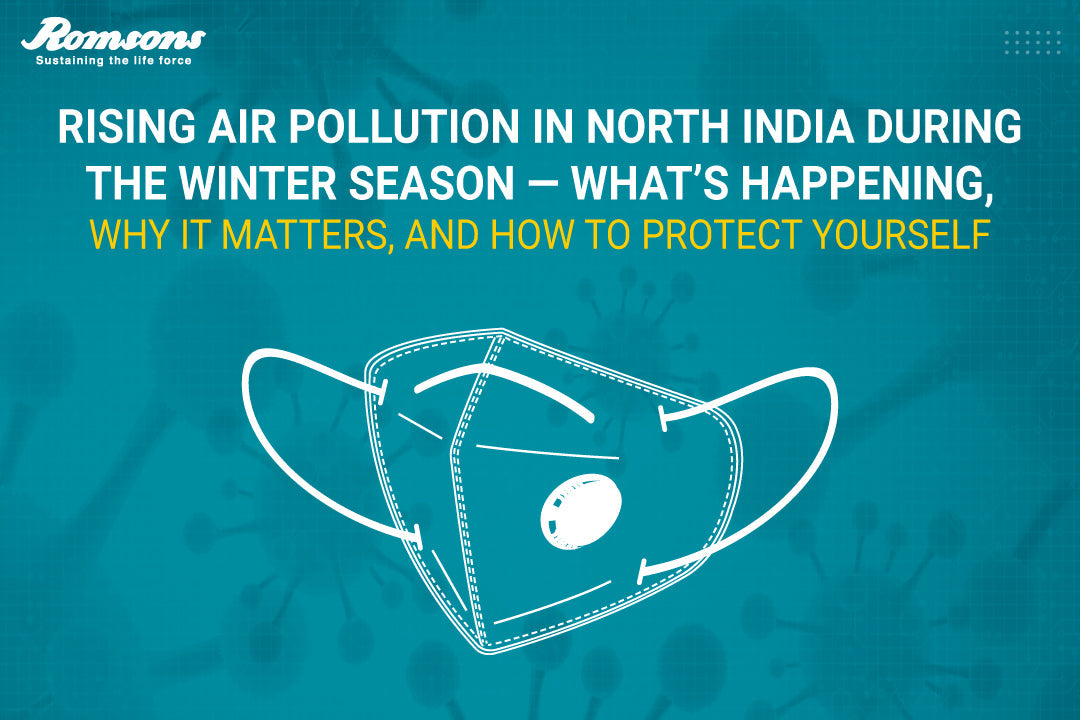Rising Air Pollution in North India During the Winter Season — what’s happening, why it matters, and how to protect yourself

Every year as temperatures drop across North India, a familiar but dangerous pattern returns: the skies turn grey, visibility falls, and air-quality alerts flash across phones. From Delhi to Lucknow to small towns across Punjab and Haryana, winter brings a spike in fine particulate pollution (PM2.5 and smaller) that harms lungs, hearts, and everyday life. This guide explains the seasonal causes, the health risks, and practical steps you and your family can take — including choosing effective masks such as the Romsons PM0.3 Nanofiber Anti-Pollution Mask and Romsons PM0.3 Child Mask.
Why pollution gets worse in winter
Several factors converge every autumn–winter to trap and concentrate pollutants over the Indo-Gangetic Plain:
- Crop-Residue (stubble) Burning in Punjab, Haryana and parts of Uttar Pradesh releases huge plumes of smoke that travel downwind into Delhi and neighbouring regions. While burning has declined in some areas, it remains a major seasonal contributor.
- Unfavourable Meteorology — Cooler nights, temperature inversions (warm air sitting above cold ground-level air), low wind speed and stable layered air — prevent pollutants from dispersing, so emissions accumulate near the surface.
- Local emissions from vehicles, diesel generators, industrial sources, construction dust, and the spike in combustion (heating, garbage burning, fireworks around festivals) add to the burden. Diwali and similar events often cause short-term surges.
The Result: seasonal winter averages and episodic peaks of PM2.5 that can be many times higher than WHO guideline levels. Monitoring groups and researchers have repeatedly documented very high winter PM2.5 in Delhi and other North Indian cities.
What the numbers mean for your health
Fine particulate matter (PM2.5 and even PM0.3 — particles smaller than 0.3 microns) penetrates deep into lungs and can enter the bloodstream. Short-term exposure can:
- Trigger coughing, wheezing, chest tightness and breathing difficulties.
- Worsen asthma and chronic obstructive pulmonary disease (COPD).
- Increase risk of heart attacks and strokes in vulnerable people.
Long-term exposure raises the risk of chronic respiratory disease, heart disease, and even premature death. The WHO provides evidence-based guidelines and summaries of these risks.
How to protect yourself — sensible, evidence-based steps
1. Follow Air Quality Alerts and Act Accordingly
Check local AQI from official monitors or reliable aggregators. On “Very Poor” or worse days, minimize outdoor time, especially strenuous exercise. Schools and workplaces often shift activities based on AQI warnings.
2. Improve Indoor Air
- Keep windows closed when outdoor AQI is very poor.
- Use a portable HEPA air purifier in bedrooms or the main living area when possible. Even a box-fan + filter setup reduces indoor PM.
- Avoid indoor sources of smoke (cooking on chulhas, incense, tobacco, or burning waste) on bad days.
3. Masks: Choose One That Actually Filters Fine Particles
Not all face masks are equal. For protection against tiny particles (PM2.5 and submicron particles), look for multi-layer masks with proven filtration and a good seal around the face.
Two product examples designed for this purpose are the Romsons PM0.3 Nanofiber Anti-Pollution Mask and the Romsons PM0.3 Child Mask. These masks advertise nanofiber/melt-blown filter layers and filtration performance against particles down to 0.3 microns — a meaningful feature for reducing inhalation of fine particulate matter. They are light-weight and designed for comfort during daily use. If you’re buying masks for children, choose age-appropriate sizes and ensure the mask fits snugly without gaps.
A few practical tips when using masks:
- Ensure a good seal (no large gaps at nose or cheeks). A high-filtration mask that leaks around the sides loses much of its benefit.
- Replace disposable filters/masks as recommended — they lose efficiency when dirty or moist.
- For those with respiratory conditions, consult a clinician before relying solely on masks for protection.
4. Extra Caution For Vulnerable People
Children, older adults, pregnant women, and those with heart or lung disease are more vulnerable. On hazardous days, limit outdoor exposure, keep medications handy, and consider moving high-risk activities indoors or postponing them. Try to maintain a healthy air indoors with the help of air purifiers.
5. Community-Level Steps Matter
Individual measures help, but long-term improvement requires policies: better agricultural-residue management alternatives, cleaner fuels and vehicles, stricter industrial controls, construction-dust management, and coordinated regional action to reduce emissions. Recent analyses and reports highlight that solutions must go beyond short-term crackdowns and address structural drivers.
When to Seek Medical Attention
Get urgent medical help if someone develops severe shortness of breath, bluish lips, fainting, or chest pain. For worsening cough or persistent wheeze, contact your doctor — they may adjust inhalers or medications temporarily during high-pollution periods.
Choosing and Using a Mask — Quick Checklist
- Does it claim filtration at PM0.3 or PM2.5 and show product details (e.g., Romsons PM0.3 Nanofiber Mask / Romsons PM0.3 Child Mask).
- Does it fit snugly around the nose and cheeks
- Is it comfortable for the duration you need to wear it
- Replace disposable masks or filters following the manufacturer’s guidance
Winter air pollution in North India is a recurring, complex public-health challenge driven by a mix of seasonal agricultural practices, emissions and weather that traps pollutants close to the ground. Individuals can reduce risk by monitoring AQI, improving indoor air, using effective masks (including PM0.3-rated options like Romsons’ adult and child masks), and taking extra care for vulnerable family members. But meaningful, lasting relief depends on coordinated policy, cleaner technology, and sustained action at scale.

